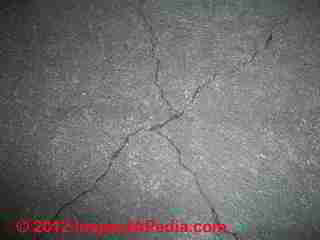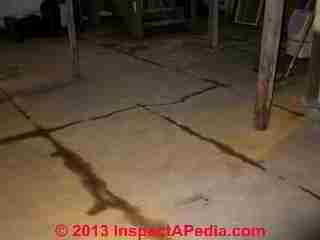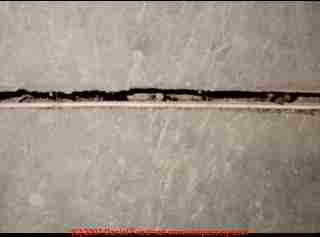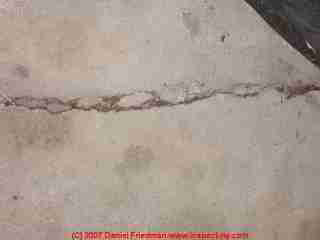 Repair Concrete Slab Cracks / Settlement Damage
Repair Concrete Slab Cracks / Settlement Damage
- POST a QUESTION or COMMENT about how to repair cracked or settled concrete slabs, floors, or foundations
Concrete slab crack repair methods:
This article describes methods for repair of cracks that occur in poured concrete slabs or floors and explains the need for accurate crack cause diagnosis and impact on structure before repairs are attempted.
Cracks in concrete floors or slabs occur in poured concrete slabs may be found both in basement and in slab on grade or "patio home" construction and have a variety of causes and cures that we discuss here. This article series describes how to recognize and diagnose various types of foundation failure or damage, such as foundation cracks, masonry foundation crack patterns, and moving, leaning, bulging, or bowing building foundation walls.
InspectAPedia tolerates no conflicts of interest. We have no relationship with advertisers, products, or services discussed at this website.
- Daniel Friedman, Publisher/Editor/Author - See WHO ARE WE?
Repair Methods for Cracks in Concrete Slabs & Floors
[Click to enlarge any image]
Types of foundation cracks, crack patterns, differences in the meaning of cracks in different foundation materials, site conditions, building history, and other evidence of building movement and damage are described to assist in recognizing foundation defects and to help the inspector separate cosmetic or low-risk conditions from those likely to be important and potentially costly to repair.
Our photo (left) shows cracks developing in a slab on grade in a homein Alaska. Built over thawing permafrost, the cause of these cracks needs to be understood before a proper repair can be designed.
Article Series Contents
- CONCRETE SLAB CRACK REPAIR
- CONCRETE SLAB CRACK EVALUATION
- CONTROL JOINT CRACKS in CONCRETE
- CRACK REPAIR STANDARDS for FLOORS
- POLYURETHANE FOAM INJECTION CRACK REPAIRS
- SEAL CRACKS in CONCRETE, How To
- SHRINKAGE CRACK REPAIR
- VERTICAL FOUNDATION MOVEMENT REPAIR
- FOUNDATION DAMAGE by MATERIAL or INCLUSIONS
Accurate Diagnosis of Slab Crack Cause, Impact on Structure, Repair Needs
Before attempting to choose a repair method for concrete floor slab cracks,
Diagnose the cause of the slab movement and cracking. Only by an accurate diagnosis of the cause of cracking or movement in a floor slab can we be assured that the crack repair will be durable and appropriate. In fact some types of floor cracks, such as hairline concrete shrinkage cracks may not need repair at all.
In contrast, a concrete slab may have settled over poorly-compacted or washed-out fill (such as in some garages) without cracking (tipping instead), but repair may still be necessary to correct slope, provide drainage, or to prevent further settlement or even collapse.
Types of Cracks in Slabs
Each type of basement slab, floor slab, or slab on grade crack is discussed and described in articles at this website. Understanding the differences among these concrete crack types is an important first step in diagnosing their cause and their significance to the structure.
- Shrinkage cracks in a slab are unlikely to be of any structural concern but can be a source of water entry or radon entry in buildings and may form
a tripping hazard. The photo at left shows a typical concrete slab shrinkage crack.
Details are at SHRINKAGE CRACKS in SLABS
Also see SHRINKAGE vs EXPANSION vs SETTLEMENT. - Settlement cracks in a slab indicate inadequate site preparation, such as failure to compact fill on which a slab was poured.
See SETTLEMENT CRACKS in SLABS for details. - Frost heaves or expansive soil damage can cause substantial damage to basement, crawl space, or garage floor slabs in some conditions.
See FROST HEAVE / EXPANSIVE SOIL CRACKS in SLABS for details.
List of Slab Crack Repair Methods Articles
Please see the individual slab crack repair articles listed below
- Control Joint Cracks in Concrete - adding control joints may be necessary to reduce further slab cracking if the joints were omitted in the original construction
- SEAL CRACKS by POLYURETHANE FOAM INJECTION - non-structural cracks (often the case with poured floor slabs) may simply need to be sealed in floors (or walls) to stop leaks
- SEAL CRACKS IN CONCRETE, HOW TO - more poured concrete crack sealing methods
- Standards for Repair of Cracks in Floors - so how bad does a crack have to be in order to decide that repair is necessary?
Cracks come to the job along with the concrete, riding in the same truck!
At a Journal of Light Construction conference (Boston 1985) a lecturer informed us that "Every concrete truck that comes to your job to pour a slab has at least four cracks in it. It's up to you to either provide control joints, or not. If you leave out control joints the cracks will occur in a messier pattern at natural stress points in the slab."
The bad news about typical floating slab construction (where the soil is not compacted) is that anything that causes the soil to settle risks slab cracking and settlement. Flooding, leaks, or simply poor handling of roof and surface runoff can send water under a building where it causes loose soil to settle.
The good news about cracks in floating slab construction is that the damage is to the floor, not to the structure that is supporting the building. Only if you see a floor slab crack that continues up in the foundation wall where the crack meets the wall would the structure be obviously involved.
More good news: if there is significant soil settlement under a floating slab, the slab is likely to break and follow the settling soil downwards; a sudden precipitous collapse of a floating slab is less likely than the next case we describe.
Standards for Repair of Cracks in Concrete Floors
Settlement cracks may form a tripping hazard even if they are not traced to a structural concern.
While there are few construction acceptance standards for floor slab cracking, one, "Quality Standards for the Professional Remodeling Industry" NAHB, recommends that cracks in basement floors which exceed 3/16" in width or 1/8" in vertical displacement should be repaired.
The same standard provides that cracks in slab-on-grade floors shall not exceed 1/16" in width or in vertical displacement.
The same standard provides that cracks occurring in control joints in concrete slabs are normal and acceptable. [We suggest that this last criteria should apply to crack width but not to vertical displacement.
How to Identify & Evaluate Shrinkage Cracks in Poured Concrete Slabs
Please see the main text version of this article at Shrinkage Cracks in Slabs
We discuss the recognition and significance of concrete shrinkage cracks in detail at Shrinkage Cracks in Slabs. Just below you can read a summary of this topic.
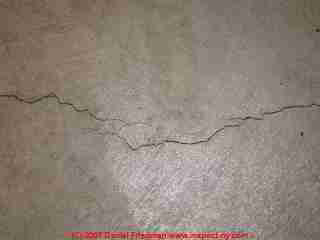
Shrinkage cracks in poured concrete are easily recognizable and can be distinguished from other types of cracks that occur later in the life of a foundation wall or floor slab.
The photograph of cracks above were taken of shrinkage cracks in a concrete slab floor in a home built in 2006. The cracks in this case ranged in width (measured across the crack) from "hairline" (less than 1/16") to about 3/32" in the basement floor slab of this particular home. They may appear larger.
What is unique about shrinkage cracks in concrete is that they usually appear to be discontinuous, as shown in this photo. The crack will meander along in the concrete, taper to a stop, and then continue beginning in a parallel line to the first crack, meandering again through the concrete. This is characteristic of concrete (or mud) shrinking while giving up its moisture.
You can see the shrinkage of even a perfect concrete floor slab with no visible cracks in the field of its surface if the floor was poured inside of an existing foundation. Look for the gap between the edges of the slab and the foundation wall?
Look also for the stains or concrete debris on the wall at the slab level? T
hese confirm that at the time the slab was poured it was touching the wall.
Shrinkage Cracks in a Basement or other Slab May Be Severe and May Combine with Settlement
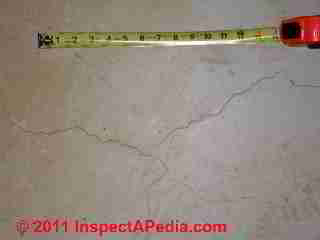
Depending on the mix and pour conditions as well as the site work preparation significant concrete shrinkage cracks can appear in a basement slab. On occasion we may also see vertical dislocation in a floor slab crack, that is, one side has settled or tipped away from the other side of the cracked concrete.
Our photographs above show shrinkage cracking and ensuing minor settlement cracks occurring in the same poured concrete basement floor. We suspected that site drainage defects or possibly nearby site blasting for additional construction contributed to the 1/16" to 1/8" vertical dislocation across some of the cracks in this floor where the cracks were about 3/16" wide.
Slab Cracks may Permit Basement Water Entry or Radon Gas Entry
Happily the building owner at the site where we made the photos above did not report water entry through these openings, though it certainly might be expected as the home ages and its footing drains stop working, particularly if surface runoff and roof runoff are not kept away from the building.
Photos of Concrete Floor Slab Shrinkage Points of Origin
The photo at left shows some concrete shrinkage cracks that are larger than usual. Note that these cracks begin at building foundation wall inside projection corners - a condition that probably creates stress points as the slab cures.
If you click on and enlarge the photo you can see clear evidence that the cracks are discontinuous, multiple, and very roughly parallel in this area - good evidence that they were caused during the concrete curing process and not by a later event which "broke" the slab.
When we see combined slab shrinkage and slab settlement condition we suspect that the concrete pour not only allowed for excessive shrinkage, or perhaps shrinkage without control joints, but also the pour was made on top of poorly prepared soils. For example if a slab is poured on poorly-compacted soil, after shrinkage cracking occurs, we may see uneven settlement among sections of the cracked slab.
Settlement cracking following shrinkage cracking may also occur. In both of these cases we anticipate that significant horizontal dislocation in a poured concrete slab should be small unless steel reinforcement was omitted or was improperly installed. Since some contractors use a fiber-reinforced cement and may omit steel reinforcement in floor slabs, this condition may occur.
How to Inspect & Evaluate Cracks at Control Joints in Concrete
We discuss the recognition and significance of control joints in poured concrete slabs in detail at CONTROL JOINT CRACKS in CONCRETE. Just below you can read a summary of this topic.
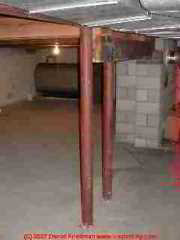
The first photograph shows an expansion joint in a basement floor slab. Notice that we do not see other cracks in this slab.
Shrinkage cracks that occur at control joints
such as shown in the second, close up photo here, are occurring where they are supposed-to, although the width of this particular crack was surprisingly large. These cracks are not normally a defect in the slab but may be a source of water or radon entry into the building and may need to be sealed. Use a flexible sealant.
Settlement Cracks in poured Concrete Slabs
We discuss the recognition and significance of settlement cracks in poured concrete slabs in detail at Settlement Cracks in Slabs. Just below you can read a summary of this topic.

Settlement cracks in a conventional concrete floor slab
which has been poured inside a separate foundation wall (and often resting at its edges on the building's foundation wall footings) are usually not connected to the foundation wall and are not supporting any structure [except possibly Lally columns, discussed next].
These cracks may not be a structural concern, but there are cases where a serious hazard can be present, such as garage floor cracking when the floor was poured over soft, loose, inadequately-compacted fill and where the floor slab was not pinned to the garage foundation walls.
Soil settlement under a garage floor, perhaps aggravated by groundwater which can increase soil settlement, can lead to first hollowing-out of space below the floor and second, sudden collapse of the floor structure.
We have used a heavy chain, dragging it across the garage floor and listening to changes in the sound it produces, to find areas of significant soil voids below the floor. The pitch of the chain noise drops significantly when passing over a void below the concrete.]
Settlement cracks in a concrete floor around a supporting Lally column
might be indicative of a serious problem such as building settlement if the columns are settling. Independent footings may have been provided supporting Lally columns in the building interior and those may be settling independently of the floor slab which may have been poured around and even over them (See photo above).
ut beware, where slab thickness and local building codes allow, supporting columns may bear directly on a poured floor slab without their own (deeper) pier or footing. In that case floor slab cracking and settling can cause column movement and may be a structural concern.
Settlement cracks in a monolithic slab or floating slab floor
may be more serious, depending on their extent since in this case the edges and other portions of the slab are, unlike the cases above) expected to support the upper portions of the building structure.
A monolithic concrete slab
is one which includes the building footing as part of the slab, created in a single continuous pour of concrete.
A floating concrete slab
is one which is poured at a (generally) uniform thickness on the ground without a separate footing. [Beware, in areas of wet soils, expansive clays, freezing climates, or unstable soils, floating slabs may be exposed to extra stresses and may tip or crack. Proper site work and drainage are important as is proper engineering design of such structures.
Frost Heaves or Expansive Soil Cracks in Poured Concrete Slabs
We discuss the recognition and significance of frost heaving damage and cracks in poured concrete slabs in detail at Frost Heave/Expansive Soil Cracks in Slabs. Just below you can read a summary of this topic.
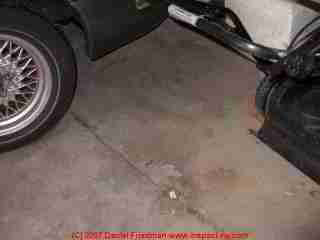
Frost heaves or expansive soils damage
to building floor slabs can range from minor to extensive in buildings depending on soil and weather conditions, site preparation, and slab construction details, as we elaborate here.
The photograph above shows a rather straight crack across a garage slab near the garage entry door. What is happening here and why is this particular crack straight if it's a frost or soil heave crack?
In freezing climates building foundations include a footing which extends below the frost line. This is true for both the occupied space as well as garages. When a concrete slab is poured either abutting the top of such a foundation, or poured extending over the edges of such a foundation, there is risk of cracking across the concrete at the interior edge of the buried footing.
The combination of water under a garage floor (watch out for driveways and sites that slope towards the garage or home) and freezing can cause the portion of the slab which rests directly on the soil to move up and down during freeze/thaw cycles. S
ince a garage is often colder near the garage entry door than in other areas, there is extra risk of these cracks occurring there, but they can occur anywhere. When there is freezing and heaving of a slab, particularly one which omitted reinforcing steel, or did not extend the steel over the footing, these garage floor slab cracks may appear during freeze/thaw cycles.
Similar floor slab damage might occur in areas of expansive clay soils if the proper moisture level is not maintained.
Basement floor heave patterns - frozen floor drains:
Basement floors can be frost heaved in other patterns in buildings which are unheated or which lose heat. We have found basement floor slabs broken and heaved above buried drain lines which ran below the basement floor of a home which remained unheated during freezing weather.
A clogged drain sitting full of liquid combined with prolonged freezing weather was the culprit in most of these cases. The heaved concrete was raised following exactly the path of the frozen (and burst) buried, clogged drain line. This problem can be epidemic in older homes which were constructed using a downspout drain line extending below the basement slab.

Basement and garage floor random heave and crack patterns:
Cracked and heaved concrete or settled concrete can occur in more random patterns in any concrete floor where there has been frost heaving, soil contraction/expansion, or simple soil settlement, as shown in this photograph.
Garage or basement floor sloped or semi-uniform settlement
may also produce a tipped floor even if the concrete is not cracked, or the floor may settle uniformly. This condition occurs if the concrete was reinforced by steel or fiber cement, but was poured inside of a separate concrete or masonry block foundation.
We see this condition more often in garages in which the slab was reinforced but poured on poorly-compacted soil. The problem may be worst if in addition to poor compaction, water runs under the slab, causing additional or more rapid soil settlement.
My first construction job (for pay) was to rake level the backfill soil that the contractor had dumped inside of the newly-completed garage foundation in a series of homes. No compaction of any kind was performed. When a lot of fill, several feet or more in depth, was required to bring the slab to the desired height, there was a good chance that the slab would settle or tip in the future.
Garage slabs which were poured inside of the foundation walls but which were pinned to the foundation sides (typically using re-bar set into holes punched into the masonry block foundation), the slab was resistant to settlement or movement even if there was modest soil settlement below.
In a garage where the slab has settled you can often spot the original level of the slab and thus can measure the amount of settlement. Look for a concrete line above the level of the top of the slab and found along the masonry block or poured concrete foundation wall. we have seen this line ranging from a fraction of an inch to six to eight inches above the current level of the slab!
Standards for the Acceptance or Repair of Cracks in Concrete Floors in New Construction
Settlement cracks may form a tripping hazard even if they are not traced to a structural concern. While there are few construction acceptance standards for floor slab cracking, one, "Quality Standards for the Professional Remodeling Industry" NAHB, , recommends that cracks in basement floors which exceed 3/16" in width or 1/8" in vertical displacement should be repaired. T
he same standard provides that cracks in slab-on-grade floors shall not exceed 1/16" in width or in vertical displacement. The same standard
provides that cracks occurring in control joints in concrete slabs are normal and acceptable. [We suggest that this last
criteria should apply to crack width but not to vertical displacement.]
...
Reader Comments, Questions & Answers About The Article Above
Below you will find questions and answers previously posted on this page at its page bottom reader comment box.
Reader Q&A - also see RECOMMENDED ARTICLES & FAQs
On 2021-03-07 by (mod) - how do we repair this crack along the length of our concrete floor
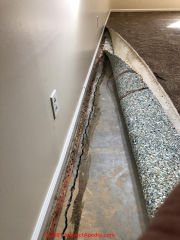
@JD,
In the live links to Recommended Articles above or in the ARTICLE INDEX please see
CONCRETE SHRINKAGE CRACKS
CONCRETE SHRINKAGE CRACK REPAIR
and perhaps for that location you'll try a polyurethane sealant - also above see
POLYURETHANE FOAM INJECTION CRACK REPAIRS
On 2021-03-07 by JD
Slab built end unit condo. Inspection under the carpet revealed crack spanning the length of the room. What type of repair would this likely require?
On 2019-10-26 - by (mod) -
I suspect there was a stress point.
It would be great if you would attach some photos, one per comment, so we can see the situation
On 2019-10-25 by Henry
I designed a semi circular gate canopy 14' wide with a span of 20' and cracks were realised on the 13th day when we removed the formwork.These were formed at the point where the curve meets the supporting beams....what could be the cause and what is the remedy for such an instance...?
On 2019-08-28 by (mod) -
No. YOu posted this question and we replied in detail at inspectapedia.com/structure/Concrete_Crack_Repairs_Sealants.php
SEAL CRACKS in CONCRETE, HOW TO
On 2019-08-28 by robert paganoni
when tide comes in and cracks in floor leak will a pressure relief valve stop leaks
On 2018-09-24 by (mod) -
In order to decide what to do about a crack in a concrete slab we need to have some diagnosis of its cause, and its history, that is over what period of time the cracking has occurred, and other site factors that may affect it such as control of water or surface runoff, original site preparation, compaction of backfill, reinforcement of the slab, Etc.
Forgive me but without any of that information I don't think that a guess about what to do to prevent further cracking would be very reliable.
On 2018-09-24 by Cynthia
We have a crack outside on the concrete slab, below our decking. The crack runs the entire width of the slab. What would you suggest we do to keep this from getting worse/wider?
Thank you!
On 2018-05-04 by (mod) -
Andy
I suspect that the concrete mix was incorrect, perhaps too much water and sand and gravel and not enough concrete. YOu'll need to remove and replace the footer.
On 2018-04-28 by Andy
I poured a 10 inch thick footer and it is 16 inches wide I let the footer set for 1 day and then the next day I layed 120 block on it,the next day I layed 300 block ,
then a day later I layed 300 more block,then I let it set for the winter,my wall cracked in two spots ,when spring came I dug down to the bottom of the footer and I noticed that only 7 inches of the footer set up and the other 3 inches of the footer was soft,I was wondering how did that happen and how do I fix it
On 2017-11-15 by (mod) -
Around the column you see a crack in the slab - what, radiating out from the column or just a circle around the column?
The first question is: is the column settling down through the slab: is it separated from the beam overhead, or is the beam sagging? If so your contractor will need to support the beam, open the floor, build a proper pier and install a new column.
On 2017-11-15 by Md. Rashed
How to repair slab crack ...
the crack see in around the column
On 2017-04-20 by (mod) -
Jorge, I can't diagnose the cracks and loose concrete from just your one line text - as there are plenty of possible causes: building movement, water, frost, impact, improper construction, foundation settlement, omission of a control joint, or simply poor mix of the concrete.
https://inspectapedia.com/structure/Concrete_Floor_Cracks.php might help you understand the crack s' cause and impact on your structure.
On 2017-04-20 by jorge
We noticed cracks on the concrete slab on second floor and some loos pieces of concrete. What can cause this?
On 2017-03-15 by (mod) -
Anon since slabs are flat - and walls are vertical, I think you're saying that there's a crack at the slab-to-wall intersection; that may be due to slab shrinkage if construction is new, or slab settlement.
On 2017-03-15 0 by Anonymous
My contrete slab developed a crack on the wall
On 2015-06-11 - by (mod) -
Anil,
The best approach is to inspect the building carefully to find and then fix the water source.
On 2015-06-11 by Anil kamat
sir kindly guide us to seal leakage in slabs
On 2015-01-22 - by (mod) -
Larhom
An ugly, more extensive (expensive) repair is to remove tiles over the crack, install a crack-isolating mesh or membrane, then re-tile. But I'd look around the entire building inside and out to determine the nature, extent and particularly the cause of the crack as if there is significant settlement going on that needs to be addressed.
On 2015-01-21 by larhom
I recently moved back into my 10 yr old AR house. I have several floor tiles throughout the house (kitchen & bathroom)that have come loose. I removed one of the 12x12 ceramic tiles used throughout the house from the bathroom floor and revealed a crack aprox .050"-1/16" wide (measured with hex wrench) and aprox 1/2" deep. It continues in both directions under tiles still in place. Also in the kitchen I have a "fairly" straight-line crack running diagonally through 4 connected tiles in the kitchen. I'm afraid my 'simple' do-it-yourself tile repair project has turned into an ugly problem. Not sure what my next step should be...
On 2014-12-01 by Anonymous
How to remove ceiling crack
On 2014-08-08 - by (mod) -
NYC
You'd want to cut or grind down the top of the un-used re-bar protrusion to below the concrete surface, then seal the surface with a weather-resistant concrete surface patch.
On 2014-08-08 by NYCitizen
I have new concrete on my outdoor porch, and after about two months I noticed there is reinforcement bar sticking thru(vertically positioned in concrete). It is very shallow but with next winter, I am afraid will be a week point. Otherwise concrete is well done, what to do about it? Thank you
On 2014-06-10 by KEN SLATER
WE ARE IN THE MIDDLE OF BUILDING A RANCH HOME IN SE WI. POURED BASEMENT FLOOR DEC 4 AND WENT UNHEATED IN SEVERE COLD UNTIL END OF FEB 2014. BASEMENT HEAVED AND CAUSED 550 LINEAR FEET OF CRACKS. WE DO NOT HAVE A "WATER PROBLEM". THE BASEMENT SETTLED DOWN UPON BEING HEATED AND IS WITHIN STANDARDS FOR WIDTH AND HEIGHT, HOWEVER WE HAVE A JIGSAW PUZZLE WITH MANY PIECES. SHOULD WE ACCEPT THIS AND IF NOT HOW SHOULD THE BUILDER REPAIR THIS.
...
Continue reading at CONTROL JOINT CRACKS in CONCRETE or select a topic from the closely-related articles below, or see the complete ARTICLE INDEX.
Or see CONCRETE SLAB CRACK REPAIR FAQs - questions & answers posted originally at this page
Or see these
Recommended Articles
- CONCRETE SHRINKAGE CRACKS
- CONCRETE SHRINKAGE CRACK REPAIR
- CONCRETE SLAB CRACK EVALUATION
- CONCRETE SLAB CRACK REPAIR
- CONTROL JOINT CRACKS in CONCRETE
- CRACK REPAIR STANDARDS for FLOORS
- POLYURETHANE FOAM INJECTION CRACK REPAIRS
- SEAL CONCRETE CRACKS, HOW TO
- SHRINKAGE CRACK REPAIR
- SLAB CRACK REPAIR STANDARDS
- VERTICAL FOUNDATION MOVEMENT REPAIR
- FOUNDATION REPAIR METHODS
Suggested citation for this web page
CONCRETE SLAB CRACK REPAIR at InspectApedia.com - online encyclopedia of building & environmental inspection, testing, diagnosis, repair, & problem prevention advice.
Or see this
INDEX to RELATED ARTICLES: ARTICLE INDEX to BUILDING STRUCTURES
Or use the SEARCH BOX found below to Ask a Question or Search InspectApedia
Ask a Question or Search InspectApedia
Try the search box just below, or if you prefer, post a question or comment in the Comments box below and we will respond promptly.
Search the InspectApedia website
Note: appearance of your Comment below may be delayed: if your comment contains an image, photograph, web link, or text that looks to the software as if it might be a web link, your posting will appear after it has been approved by a moderator. Apologies for the delay.
Only one image can be added per comment but you can post as many comments, and therefore images, as you like.
You will not receive a notification when a response to your question has been posted.
Please bookmark this page to make it easy for you to check back for our response.
IF above you see "Comment Form is loading comments..." then COMMENT BOX - countable.ca / bawkbox.com IS NOT WORKING.
In any case you are welcome to send an email directly to us at InspectApedia.com at editor@inspectApedia.com
We'll reply to you directly. Please help us help you by noting, in your email, the URL of the InspectApedia page where you wanted to comment.
Citations & References
In addition to any citations in the article above, a full list is available on request.
- Mark Cramer Inspection Services Mark Cramer, Tampa Florida, Mr. Cramer is a past president of ASHI, the American Society of Home Inspectors and is a Florida home inspector and home inspection educator. Mr. Cramer serves on the ASHI Home Inspection Standards. Contact Mark Cramer at: 727-595-4211 mark@BestTampaInspector.com
- John Cranor [Website: /www.house-whisperer.com ] is an ASHI member and a home inspector (The House Whisperer) is located in Glen Allen, VA 23060. He is also a contributor to InspectApedia.com in several technical areas such as plumbing and appliances (dryer vents). Contact Mr. Cranor at 804-873-8534 or by Email: johncranor@verizon.net
- Quality Standards for the Professional Remodeling Industry, National Association of Home Builders Remodelers Council, NAHB Research Foundation, 1987.
- Quality Standards for the Professional Remodeler, N.U. Ahmed, # Home Builder Pr (February 1991), ISBN-10: 0867183594, ISBN-13: 978-0867183597
- "Concrete Slab Finishes and the Use of the F-number System", Matthew Stuart, P.E., S.E., F.ASCE, online course at www.pdhonline.org/courses/s130/s130.htm
- Sal Alfano - Editor, Journal of Light Construction*
- Thanks to Alan Carson, Carson Dunlop, Associates, Toronto, for technical critique and some of the foundation inspection photographs cited in these articles
- Thanks to reader Michael Witten for technical editing, October 2010
- Terry Carson - ASHI
- Mark Cramer - ASHI
- JD Grewell, ASHI
- Duncan Hannay - ASHI, P.E. *
- Bob Klewitz, M.S.C.E., P.E. - ASHI
- Ken Kruger, P.E., AIA - ASHI
- Aaron Kuertz aaronk@appliedtechnologies.com, with Applied Technologies regarding polyurethane foam sealant as other foundation crack repair product - 05/30/2007
- Bob Peterson, Magnum Piering - 800-771-7437 - FL*
- Arlene Puentes, ASHI, October Home Inspections - (845) 216-7833 - Kingston NY
- Greg Robi, Magnum Piering - 800-822-7437 - National*
- Dave Rathbun, P.E. - Geotech Engineering - 904-622-2424 FL*
- Ed Seaquist, P.E., SIE Assoc. - 301-269-1450 - National
- Dave Wickersheimer, P.E. R.A. - IL, professor, school of structures division, UIUC - University of Illinois at Urbana-Champaign School of Architecture. Professor Wickersheimer specializes in structural failure investigation and repair for wood and masonry construction. * Mr. Wickersheimer's engineering consulting service can be contacted at HDC Wickersheimer Engineering Services. (3/2010)
- *These reviewers have not returned comment 6/95
- The Journal of Light Construction has generously given reprint permission to InspectAPedia.com for certain articles found at this website. All rights and contents to those materials are ©Journal of Light Construction and may not be reproduced in any form.
- Avongard FOUNDATION CRACK PROGRESS CHART [PDF] - structural crack monitoring
- Building Pathology, Deterioration, Diagnostics, and Intervention, Samuel Y. Harris, P.E., AIA, Esq., ISBN 0-471-33172-4, John Wiley & Sons, 2001 [General building science-DF] ISBN-10: 0471331724 ISBN-13: 978-0471331728
- Building Pathology: Principles and Practice, David Watt, Wiley-Blackwell; 2 edition (March 7, 2008) ISBN-10: 1405161035 ISBN-13: 978-1405161039
- Diagnosing & Repairing House Structure Problems, Edgar O. Seaquist, McGraw Hill, 1980 ISBN 0-07-056013-7
- Design of Wood Structures - ASD, Donald E. Breyer, Kenneth Fridley, Kelly Cobeen, David Pollock, McGraw Hill, 2003, ISBN-10: 0071379320, ISBN-13: 978-0071379328
This book is an update of a long-established text dating from at least 1988 (DJF); - Building Failures, Diagnosis & Avoidance, 2d Ed., W.H. Ransom, E.& F. Spon, New York, 1987 ISBN 0-419-14270-3
- Domestic Building Surveys, Andrew R. Williams, Kindle book, Amazon.com
- Defects and Deterioration in Buildings: A Practical Guide to the Science and Technology of Material Failure, Barry Richardson, Spon Press; 2d Ed (2001), ISBN-10: 041925210X, ISBN-13: 978-0419252108.>
- Guide to Domestic Building Surveys, Jack Bower, Butterworth Architecture, London, 1988, ISBN 0-408-50000 X
- "Avoiding Foundation Failures," Robert Marshall, Journal of Light Construction, July, 1996 (Highly recommend this article-DF)
- "A Foundation for Unstable Soils," Harris Hyman, P.E., Journal of Light Construction, May 1995
- "Backfilling Basics," Buck Bartley, Journal of Light Construction, October 1994
- Slab on Grade Foundation Moisture and Air Leakage, U.S. Department of Energy
- In addition to citations & references found in this article, see the research citations given at the end of the related articles found at our suggested
CONTINUE READING or RECOMMENDED ARTICLES.
- Carson, Dunlop & Associates Ltd., 120 Carlton Street Suite 407, Toronto ON M5A 4K2. Tel: (416) 964-9415 1-800-268-7070 Email: info@carsondunlop.com. Alan Carson is a past president of ASHI, the American Society of Home Inspectors.
Thanks to Alan Carson and Bob Dunlop, for permission for InspectAPedia to use text excerpts from The HOME REFERENCE BOOK - the Encyclopedia of Homes and to use illustrations from The ILLUSTRATED HOME .
Carson Dunlop Associates provides extensive home inspection education and report writing material. In gratitude we provide links to tsome Carson Dunlop Associates products and services.


